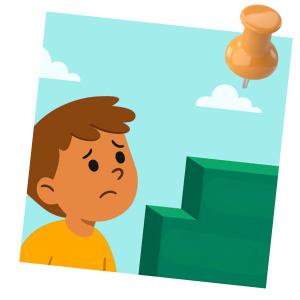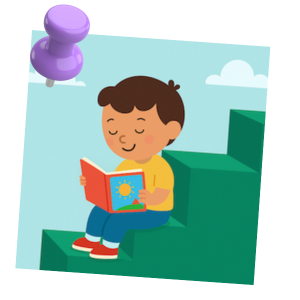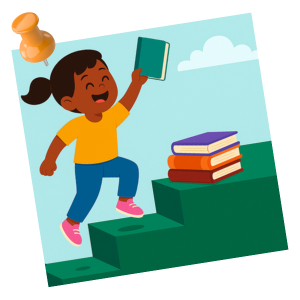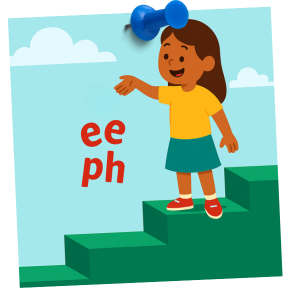
Wondering if your child is behind, on track, or ahead in phonics? This guide will clearly explain what phonics level your child should be at in Reception/Kindy, Year 1, and Year 2. I’ll also explore what can slow phonics progress, and when it’s appropriate to phase phonics out (if ever!).
School has changed a lot since I was in Primary School (personal computers hadn’t even been invented!), but some things haven’t: children still need strong reading and writing skills. Spoken language lays the foundation for reading and writing skills, enabling children to understand their world and express themselves effectively. Phonics helps children to link the sounds of spoken language (phonemes) with the alphabet letters (graphemes) we use to represent them in written language. It is important to begin phonics instruction when your child is developmentally ready.
When your child first enters school, the teacher will try to develop your child’s ‘phonemic awareness’ – the ability to hear, recognise and manipulate the individual sounds in spoken words. Three essential phonemic awareness skills are segmenting, blending and phoneme manipulation:
Phonemic awareness is very important because it lays the foundation for phonics. If a child can’t identify the sounds in words, linking those sounds to letters will be meaningless. As a parent, you can play an important role in increasing the opportunities your child has to ‘play with sounds’. I wrote a blog post for teachers, if you’d like to know more about phonemic awareness.
Phonics should follow phonemic awareness. You don’t need to delay phonics instruction until your child is achieving full marks on phonemic awareness though, as synthetic phonics will improve awareness of phonemes.

We don’t expect that children will all learn to walk or talk at the same age. We shouldn’t expect them to develop phonic knowledge and skills at the same age either! Knowledge and skill development can be impacted by brain differences as well as sensory and environmental factors. Not surprisingly, hearing, speech or language deficits often slow progress in phonics because they make it challenging to identify and/or produce the sounds to be read or written. A student with one of these deficits will often need support at school and extra practice in order to make progress. Another obvious cause of slowed progress in phonics is the presence of a specific learning disability such as dyslexia, dysgraphia or dyspraxia. These lifelong neurodevelopmental conditions impact ability to identify and/or record sounds so ongoing support is often required.
Systematic and explicit instruction is vital for all children so the absence of this (due to gaps in school attendance or poor teaching practice) will slow progress. Do you see differences between the progress of your son and your daughter? Research shows that even with the same amount and quality of instruction, girls typically outperform boys on verbal and language tasks, presumably due to differences in the way their brains process information. Encouragement and practice at home can increase progress – without that support the gap between children meeting expectations and children falling below expectations is likely to increase.
Some English sounds don’t exist in other languages. For example, /th/ isn’t found in many Asian or European languages. Second language learners may need additional exposure to new phonemes and pronunciation practice.

English is a challenging language to read and write because it has 44 sounds but only 26 letters to represent them. To maximise progress, introduce letter-sound correspondences (e.g. /e/, /sh/ or /air/) in a logical way, moving from simple (e.g. the sound /s/) to complex understandings (e.g. /ay/). Have a look at the logical order followed by Phonics Hero.
It’s also critical that you pronounce the sounds correctly.You can hear the sounds and see their representations with the Phonics Hero audio and video tool.
By the end of Reception/Kindy a child should be able to:

By the end of Year 1 a child should be able to:

By the end of Year 2, a child should be:
It is generally assumed that students will ‘learn to read’ in their first three years of full-time schooling and ‘read to learn’ from the beginning of their fourth year at school.

Phonics Hero mirrors what’s taught in school, following the phonics code step by step:
It provides everything your child needs to keep progressing with phonics—at their own pace, in the right order. You can sign up for a 7-day trial and see the difference the extra practise makes to your child.

From Year 3 onwards, as children’s phonics skills increase, the teacher will devote less time to phonics and shift the emphasis to other parts of reading and spelling such as vocabulary or comprehension. Phonics instruction will not stop here. Children will need to refine their phonic knowledge for spelling in Year 3 and beyond because spelling is harder than reading. Even as adults we sometimes need the help of Siri to spell words! There is no set ‘completion date’ for the teaching of phonic knowledge and skills because:
It is important to provide high quality systematic phonics instruction for a child, in Primary and Secondary school, for as long as it is needed.
Whether children are behind, on track, or ahead when it comes to phonics, the focus should always be moving them from where they are at to the next small step up in understanding and skill. Children learn at their own pace – the important thing is that they keep making progress. I like this quote from Robert John Meehan:
“Each child is unique, not only capable of learning but also capable of succeeding.“